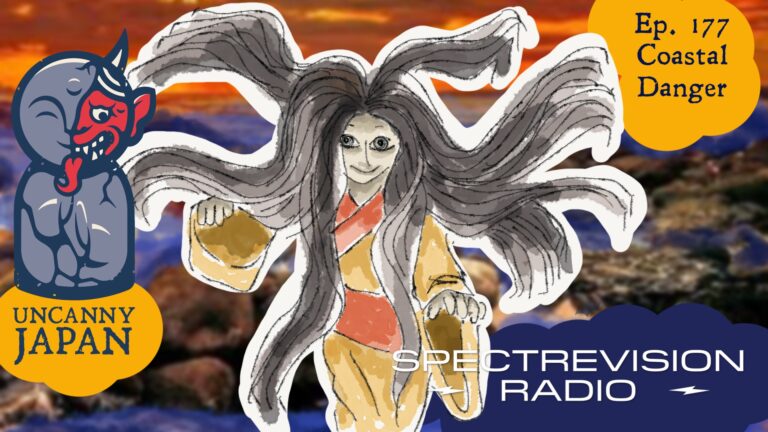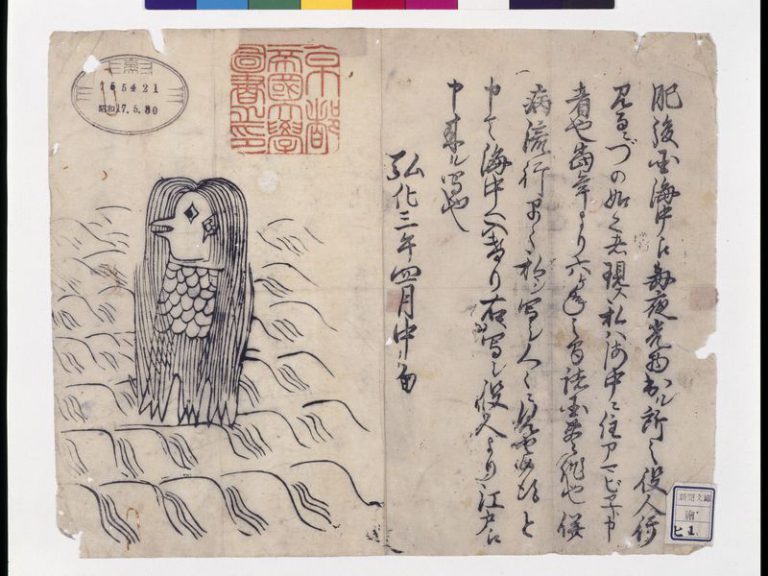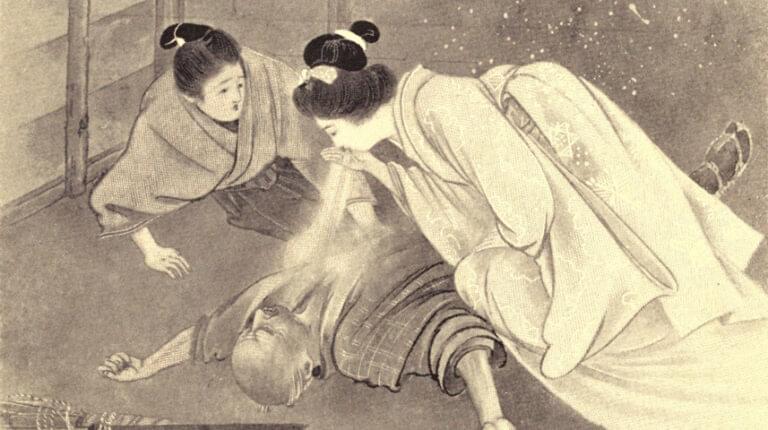Hey, hey, I’m Thersa Matsuura and you’re listening to Uncanny Japan. Trees. I love trees. We all love trees. So let’s talk about trees, but not the normal kind, although they’re pretty awesome. Let’s look into the supernatural ones, the potentially deadly kind. For example, have you ever found yourself out walking in a forest and you’re completely alone, but you don’t feel that way? It’s like someone is there watching you. You can’t tell where they are. It seems like they’re kind of everywhere all at once. It’s not so much a dangerous feeling, more of an ancient, powerful, primeval presence. Maybe you hear something, a low reverberating groaning sound or a sudden high-pitched screeching. It’s all a little unnerving. When you turn trying to find out what it is that’s looking at you, you might just see a ghostly ball of light flitting about in the distance. Maybe something is there observing you.
My name is Thersa Matsuura and Uncanny Japan is a podcast about mysterious yōkai, fascinating folktales, and more. Let’s talk about creepy trees.
Kodama: Ancient Tree Spirits
First, exciting news you’re going to absolutely love. Right now, go put your pants on and grab your keys, then head out to your favorite comic book store and tell them to add David Dasmalchian’s Knights vs. Samurai to your pull list. Because the first issue is coming out September 25th. Meet Sir Charles Ward, also known as the Dragon Butcher, and his diverse and multi-talented band of warriors, as they head to the Far East seeking vengeance on whatever savage monsters ambushed a group of English missionaries. Imagine their surprise when they land on the shore of this faraway country and find a regiment of samurai waiting for them. I also recommend following Good Fiend Official on Instagram for updates and introductions to all the characters that I guarantee you’re going to fall in love with. My personal crush is Sanada Musashi, the Tiger Lord, who artist Fede Mele depicted divinely. And he brought all the characters to life better than I could have imagined. So check that out, Good Fiend Official on Instagram. Also thank you for buying and reviewing the Book of Japanese Folklore. For reviews, I just passed 50 and that’s like a very special milestone. So thank you, thank you, and keep it up if you haven’t. Alright then, today I’m going to tell you about a handful of supernatural trees or tree spirits. Let’s start with the kodama, which are the spirits or kami that often show up like the ones I described in the intro. The first thing I noticed interesting about the kodama was that there are three different versions of their name. In all three, the first character, ko, is tree, but the dama part can be the kanji for rei, like yūrei, meaning ghost or spirit, or tamashi, meaning soul, or the character for fascination or charm. So it’s interesting to pay attention and see how they’re used in different situations. You might be familiar with the kodama from the Ghibli film mononoke-hime, Princess mononoke.
Miyazaki’s Kodama and Ancient Origins
Miyazaki Hayao’s version of the kodama are these freaky, ghostly, childlike creatures with black, gaping eyes and mouths, and lopsided heads that do this wind-up-and-release thing. It’s just brilliant. As far as I can tell, those are completely original kodama. So well done. Since most of the time, these tree spirits are completely invisible. So Miyazaki’s version is the most recent one of these kodama. But if you go way back, where do they come from, and what exactly are they?
Kodama are considered kami, gods or spirits, and you can find a very early version of them mentioned in the Kojiki, 712 CE. Here they go by the adorable name of kuku-nochi-no-kami, or spirits of the wood, or tree gods. Much later, but still long ago, in 1776, the artist and storyteller Toriyama Sekien drew his interpretation of what these kodama look like. His depiction is in Gazu Hyakki Yagyō, Illustrated Demon Horde’s Night Parade. His tree spirits were an elderly man and woman carrying a rake in a broom and stepping out of an old tree. The explanation reads something like, when a tree reaches the age of 100 years old, it means a spirit that will allow itself to be seen. But kodama aren’t just ethereal or elderly tree spirits bopping about without a purpose. No, their wish is for a healthy, peaceful, thriving forest, and their job is to try to protect it. One way they can do this is by appearing in someone’s dreams. And by someone, I mean a lumberjack, or anyone who is in a position to cut down a good number of trees, or better yet, to prevent it. When the tree spirits show up in a dream, they take the form of a person, and they warn the dreamer to stop their attacks on the forest.
How Kodama Protect Their Forests
If the message is heeded, all’s good. If ignored, the tree spirit can turn wrathful and resort to other means. That’s a nice chainsaw you got there. It would be a shame if something happened to it. Another interesting tidbit about the kodama is that they are not stuck to one tree. They can get up and move about, completely unseen, or as a ball of light, or a strange sound, or even as some forest animal. So this is what you feel when you’re in a forest, and you get goose bumps, and you feel like you’re being watched. You are. Kodama are generally benign and protective, but don’t mess with their trees or their forest, because they can make bad things happen. Speaking of bad things, next let’s talk about some more testy tree spirits, or yōkai. Much more dangerous, too. That’s the jumokko, or jubokko. Two characters for tree and child. Tree child. This particular tree is found on sites where great battles once were fought. All the blood spilled on the ground soaked into the tree’s roots and caused it to change, becoming a kind of yōkai that now craves blood. If you’re unfortunate enough to walk near one, it will snatch you up in its limbs, send a small tube into your body, and suck your blood. By doing this, the tree remains fresh and alive for many years. I’m assuming it’s tossing your deflated husk aside. Remember Mizuki Shigeru, the manga artist who brought us GeGeGe no Kitarō? Well, he wrote about and drew hundreds of yōkai. Some we already knew about, some were little-known creatures from all over Japan that he brought back into the light, and some he completely invented himself.
Jubokko: The Bloodthirsty Tree Child
For a long time, it was believed that jubokko, or jumokko, was one of his originals. But an old article dated 1966, before he wrote about it, was found, and it was written by a man named Morihiro Saito. The title of the article was, Special Feature, Anata no Sōba ni Iru, Nihon no Yōkai. Right beside you, Japanese yōkai. And it talked about this bloodthirsty, cursed tree. So another example of Mizuki-sensei keeping old folktales alive, so to speak. Next, there’s the tabu no ki, which is an evergreen, also called a Japanese bay tree. It is scentless, and its powdered bark is used for making incense because it absorbs other fragrances and burns well. This particular tree in question is, or was, in Shiga Prefecture, where some history happened. Nearby was the Sawayama Castle, and that’s where Ishida Mitsunari retreated after being beaten by Tokugawa Ieyasu in the Battle of Sekigahara. Only running away wasn’t going to save poor Ishida Mitsunari. Tokugawa’s forces followed, captured him, and executed him.
The Tree That Became a Woman
They also burned the castle down. There was lots of bloodshed. At a nearby temple, there stood a several hundred-year-old tabu no ki. Some time after this epic battle, the tree started acting funny. And by acting funny, I mean at night it would turn into a lovely young lady called the kimusume, or tree daughter, and play tricks on visitors to the shrine. There is also the legend of a small pond in the corner of a cemetery where flowed the blood of many people killed when the Sawayama Castle fell. For years at dusk, if you gazed into the water, you’d see the bloody face of a woman staring back at you. As for the tree that liked surprising people by appearing as a young woman, it seems the head abbot of the temple heard about this mischief and with much praying and chanting, put an end to those shenanigans. Speaking of shenanigans, watch out for camellia trees, especially old ones. Even Toriyama Sekien warned people in his book of supernatural creatures, he called them the spirits of old camellia trees. So it goes that spirits reside in these old trees, appearing as beautiful women, but with ill intent. Well, mostly they bewitch their victims, then scare them away when they get too close, although sometimes they’ll disappear a person. They can be found in different areas of Japan with their legends varying depending on the place. In Yamagata Prefecture, there’s one called the Camellia Woman. The story goes that two merchants were walking when suddenly a woman appeared beside one of them. She blew on him, and he turned into a bee. The woman vanished into a gorgeous camellia tree. The bee suddenly took notice of the flowers and flew over and landed in one.
Camellia Trees: Beautiful but Deadly
The flower dropped to the ground with a thump, and the second merchant picked it up. But alas, his friend, now a bee, was dead. He took his dead bee friend to a temple and told the story of what happened. That explains a lot, said the monk. Travelers have been disappearing right and left along that pass. Prayers were prayed, chants were chanted, and the bee merchant, along with his flower, were buried together. Before I let you go, let me tell you about the camellia flower. It used to be a very auspicious flower, even sacred back in the Heian era. That lasted for hundreds of years, even into the Edo era, when feudal lords and samurai and high-ranking hatamoto used to collect them. Camellia flowers were thought to ward off evil, and were even mentioned in the Tale of Genji, where there was a scene about eating camellia mochi to get rid of impurity. The meaning of the camellia flower is eternal beauty and impeccable charm. Remember when I talked about the very lucky trio, shōchikubai, pine, bamboo, and plum, in episode 138? Well, before the plum entered the picture, it was Shōchiku Tsubaki, with tsubaki being camellia, pine, bamboo, camellia. But then the plum came and knocked it out.
Why Camellias Became Unlucky
Somewhere along the way, some observant person noticed the way the tree drops its flowers. They don’t just shrivel and float down petals. But instead, while still quite hefty, the entire flower falls completely off and lands with an audible sound. Thunk, which reminded someone somewhere of a head being lopped off. The camellia then became associated with beheading, and all those samurai started thinking twice about having them in their gardens. For this reason, you definitely shouldn’t give camellias to anyone who is sick or in the hospital. Not so much the doctor is going to come in with a katana and hack someone’s head off. But the whole pretending death thing isn’t very nice, even though the flowers are pretty. That said, they are beautiful and helpful. These days, you can buy camellia oil that is supposed to be really good for your hair, scalp, skin. It doesn’t really have an odor, though. If you want a nice fragrance with your camellia, then you can get the shampoo here called Tsubaki. That smells really nice. And I’ll leave you with an interesting thing I read about the camellia plant. Just a single line. I read it several times in Japanese with no explanation. And that is, camellias want to talk to the dead. There’s a story in there. All right, there you go. Thank you so much for listening. Thank you patrons for supporting the show and making all this possible. You’re all the best. Everyone stay safe and well. Have an awesome two weeks. And I will talk to you in the next video.







Nice article.
I wish to meet you in person.
THank you